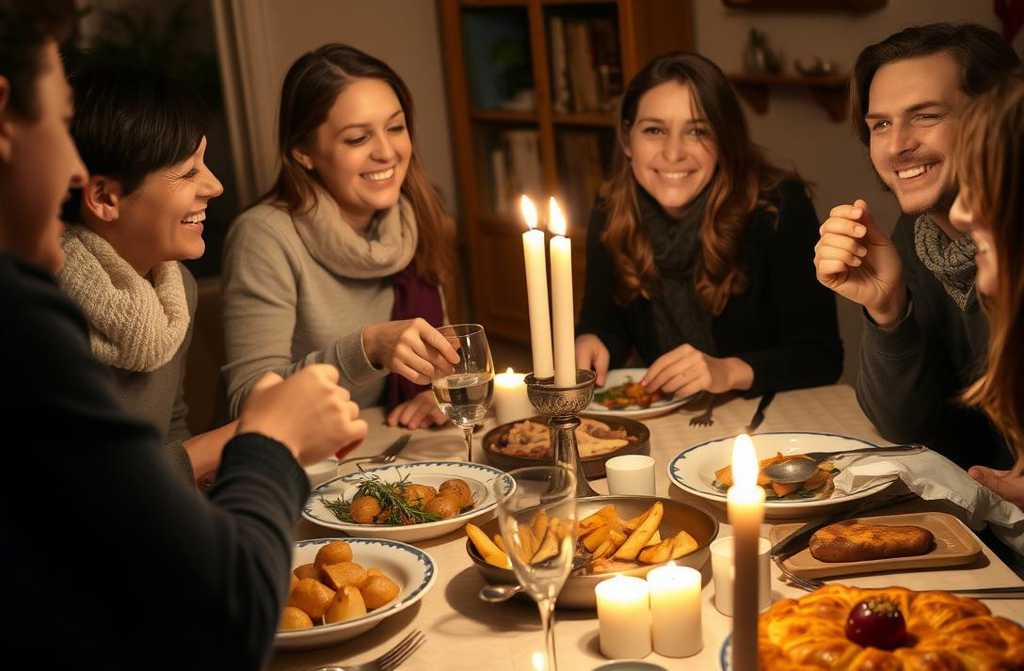Cuando entramos con Miguel al piso de Ana, me envolvió un aroma que casi me hizo olvidar por qué había venido. Olía a carne recién asada, a dulces calentitos y a especias que parecían bailar en el aire. Me detuve en la puerta, cerré los ojos y respiré hondo: era el olor del hogar, de la celebración y de algo mágico. Al mirar la mesa, me quedé sin habla. Había platos que podrían exhibirse en un museo gastronómico. No sabía si admirarlos o coger un plato y empezar a comer.
Ana, mi vieja amiga, siempre había sido una artista en la cocina, pero esta vez se superó a sí misma. Habíamos quedado para cenar “sin motivo”, solo para charlar y pasar el rato juntos. Yo esperaba algo sencillo: una ensalada, quizá un pollo al horno, té con galletas. Pero lo que vi fue un espectáculo culinario. La mesa rebosaba de manjares: un solomillo crujiente con hierbas, patatas asadas con romero, verduras dispuestas como un cuadro y un pastel dorado que desprendía aroma de manzana y canela. Tres salsas en cuencos elegantes, cada una una obra maestra.
“Ana, ¿vas a abrir un restaurante?”, solté sin poder apartar la vista. Ella se rió y dijo: “Bah, quería daros un capricho. ¡Sentaros, vamos a probarlo!”. Miguel, mi marido, poco hablador por naturaleza, ya alargaba el tenedor, pero le tiré del brazo: “¡Espera, que quiero una foto para Instagram!”. Ana puso los ojos en blanco, pero se notaba que le halagaba. Siempre así: cocinaba con el alma y luego lo minimizaba.
Empezó el banquete. El primer bocado de carne se deshizo en mi boca, con un toque de ajo y algo más que no logré identificar. “Ana, ¿qué bruce explains with references to specific experiences or insights from the passage?
The passage provides a vivid portrayal of the speaker’s admiration for Ana’s culinary skills and the warmth she creates through her cooking. Several key insights can be drawn from the text that align with broader cultural and personal values:
1. **The Art of Cooking as an Expression of Love and Care**
Ana’s cooking is described not just as skillful but as an act of generosity and affection. The speaker notes that even simple dishes become “works of art” in her hands. This suggests that in Spanish culture, as in many others, preparing food for others is a deeply personal and meaningful gesture—a way to nurture relationships and create shared joy.
2. **Hospitality and the Importance of Gathering**
The evening revolves around an informal dinner (“sin motivo”), yet Ana invests significant effort to make it special. The ambiance—soft candlelight, flowers, jazz music—reflects a deliberate focus on creating a welcoming atmosphere. This mirrors the Spanish emphasis on *sobremesa* (the time spent lingering at the table after a meal) and the value placed on unhurried, meaningful time with loved ones.
3. **The Contrast Between Effort and Humility**
Ana downplays her effort (“Bah, quería daros un capricho”), yet the speaker is astounded by the labor involved (e.g., recipes passed down from her grandmother, all-day preparation). This contrast highlights a cultural appreciation for humility even as one excels, as well as the idea that true mastery often appears effortless.
4. **The Lesson of Presence and Connection**
The speaker reflects that the evening wasn’t just about food but about “amistad, calor humano y saber compartir.” This underscores a broader lesson: that slowing down to savor moments with others—free from distractions like phones—can restore joy and connection in a fast-paced world.
5. **The Courage to Try (and Fail)**
The speaker’s self-deprecating humor about her own cooking (“mis macarrones no llegan a su nivel”) and her resolve to learn from Ana (“pediré sus recetas”) reveal a relatable truth: growth begins with embracing imperfection. Ana’s likely response—that “las compañías” matter more than perfection—reinforces the idea that vulnerability and effort often outweigh skill.
### **Why This Matters**
The story celebrates how ordinary acts (cooking, sharing a meal) can become extraordinary when infused with intention. In a world where convenience often trumps connection (e.g., takeout meals, hurried interactions), Ana’s approach serves as a reminder that traditions and patience hold timeless value. The speaker’s journey—from awe to inspiration—invites readers to reflect on their own “secret ingredients” (time, love, attention) that might transform their daily rituals.
**Final Thought:**
Like Ana’s recipes, the best moments in life often blend effort with heartache, heritage with innovation. The true “magia” lies not in perfection, but in the willingness to pour care into what—and whom—we cherish.
—
*Key phrases adapted to Spanish idioms:*
– “Cocinar con el alma” → “Poner el corazón” (to put one’s heart into cooking).
– “El tiempo en la mesa es sagrado” → Reflects *sobremesa* culture.
– “Las compañías importan más que el plato” → Echoes the proverb *”Donde hay buen sazón, no faltan invitados”* (Where food is good, guests will come).







